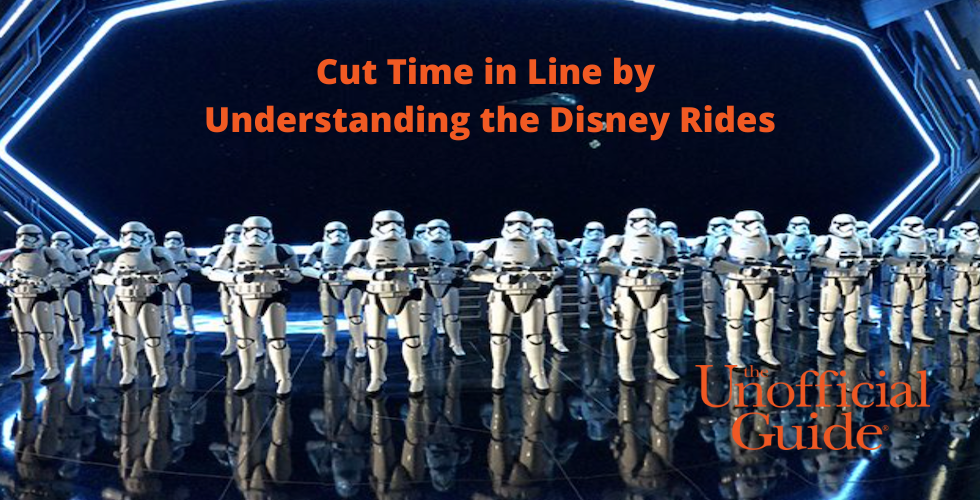Walt Disney World has many types of rides. Let’s take a look at how you can cut time in line by understanding the Disney rides. Some, such as Pirates of the Caribbean at the Magic Kingdom, can carry more than 3,000 people an hour. At the other extreme, TriceraTop Spin at Animal Kingdom can handle only around 500 people an hour. Most rides fall somewhere in between. Many factors figure into how long you’ll wait to experience a ride: its popularity; how it loads and unloads; how many persons can ride at once; how many units (cars, rockets, boats, flying elephants, and the like) are in service at a time; and how many cast members are available to operate the ride. To develop an efficient touring plan, it’s necessary to understand how rides and shows are designed to function.

1. How Popular Is the Ride?
Newer rides, such as the two new attractions at Star Wars: Galaxy’s Edge in Disney’s Hollywood Studios, attract a lot of people, as do such longtime favorites as Animal Kingdom’s Expedition Everest. If a ride is popular, you need to know how it operates in order to determine the best time to ride.

But a ride need not be especially popular to generate long lines; in some cases, such lines are due not to a ride’s popularity but to poor traffic engineering. This is the case at the Mad Tea Party and The Barnstormer (among others) in Fantasyland. Both rides serve only a small percentage of any day’s attendance at the Magic Kingdom, yet because they take so long to load and unload, long lines form regardless.
2. How Do Disney Rides Load and Unload?
Some rides never stop—they’re like conveyor belts that go around and around. These are continuous loaders. Examples include The Haunted Mansion and Under the Sea: Journey of the Little Mermaid at the Magic Kingdom, along with Spaceship Earth at EPCOT. The number of people who can be moved through in an hour depends on how many cars—“doom buggies” or whatever—are on the conveyor. The Haunted Mansion and Spaceship Earth have lots of cars on the conveyor, and each can move more than 2,000 people an hour.

Other rides are interval loaders. Cars are unloaded, loaded, and dispatched at set intervals (sometimes controlled manually, sometimes by computer). Space Mountain in Tomorrowland is an interval loader: It has two tracks (the ride has been duplicated in the same facility). Each track can run as many as 14 space capsules, released at 36-, 26-, or 21-second intervals. (The bigger the crowd, the shorter the interval.)

In one kind of interval loader, empty cars, as in Space Mountain’s space capsules, return to where they reload. In a second kind, such as Splash Mountain, one group of riders enters the vehicle while the previous group departs. Rides of the latter type are referred to as in-and-out interval loaders. As a boat docks, those who have just completed their ride exit to the left; at almost the same time, those waiting to ride enter the boat from the right. The reloaded boat is released to the dispatch point a few yards down the line, where it’s launched according to the interval being used.

Interval loaders of both types can be very efficient people-movers if (1) the dispatch (launch) interval is relatively short and (2) the ride can accommodate many vehicles at one time. Because many boats can float through Pirates of the Caribbean at one time, and the dispatch interval is short, almost 3,000 people can see this attraction during each hour.
The least efficient rides, in terms of traffic engineering, are cycle rides, also called stop-and-go rides. Those waiting to ride exchange places with those who have just ridden. Unlike in-and-out interval rides, cycle rides shut down during loading and unloading. While one boat is loading and unloading in It’s a Small World (an interval loader), many other boats are advancing through the ride. But when Dumbo touches down, the whole ride is at a standstill until the next flight launches (ditto Prince Charming Regal Carrousel and the Mad Tea Party).

With cycle rides, the time in motion is ride time, and the time the ride idles while loading and unloading is load time. Load time plus ride time equals cycle time, or the time from the start of one run of the ride until the start of the next. The only cycle rides in Disney World are in the Magic Kingdom and Disney’s Animal Kingdom.
3. How Many People Can Ride at One Time?
This figure expresses system capacity, or the number of people who can ride at one time. The greater the carrying capacity of a ride (all other things being equal), the more visitors it can accommodate per hour. Some rides can add extra units (cars, boats, and such) as crowds build, to increase capacity; others, such as the Astro Orbiter in Tomorrowland, have a fixed capacity (it’s impossible to add more rockets).
4. How Many Units Are in Service at a Given Time?
Unit is our term for the vehicle in which you ride. At the Mad Tea Party, the unit is a teacup; at Peter Pan’s Flight, a pirate ship. On some rides (mostly cycle rides), the number of units operating at one time is fixed. There are always 32 flying elephants at Dumbo and 90 horses on Prince Charming Regal Carrousel. There’s no way to increase the capacity of such rides by adding units. On a busy day, the only way to carry more people each hour on a fixed-unit cycle ride is to shorten the loading time or decrease the ride time.

The bottom line: On a busy day for a cycle ride, you’ll wait longer and possibly be rewarded with a shorter ride. This is why we steer you away from cycle rides unless you’re willing to ride them early in the morning or late at night. At the Magic Kingdom the cycle rides are Astro Orbiter, The Barnstormer, Dumbo the Flying Elephant, Mad Tea Party, The Magic Carpets of Aladdin, and Prince Charming Regal Carrousel. At Disney’s Animal Kingdom you have TriceraTop Spin at DinoLand U.S.A.
Many other rides throughout Walt Disney World can increase their capacity by adding units as crowds build. For example, if attendance is light, Big Thunder Mountain Railroad in Frontierland can start the day by running only one of its five mine trains from one of two available loading platforms. If lines build, the other platform is opened and more mine trains are placed into operation. At capacity, the five trains can carry about 2,400 persons an hour. Likewise, Star Tours at Disney’s Hollywood Studios can increase its capacity by using all of its simulators, and the Gran Fiesta Tour boat ride at Mexico in EPCOT can add more boats. Sometimes a long queue will disappear almost instantly when new units are brought online. When an interval loader places more units into operation, it usually shortens the dispatch intervals, allowing more units to be dispatched more often.

5. How Many Cast Members Are Available to Operate the Ride?
Adding cast members to a ride can allow more units to operate or additional loading or holding areas to open. In the Magic Kingdom, Pirates of the Caribbean and It’s a Small World can run two waiting lines and loading zones. The Haunted Mansion has a 1 1⁄2-minute preshow staged in a “stretch room.” On busy days, a second stretch room can be activated, permitting a more continuous flow of visitors to the actual loading area.

Additional staff makes a world of difference to some cycle rides. Often, the Mad Tea Party has only one attendant. This person alone must clear visitors from the ride just completed, admit and seat visitors for the upcoming ride, check that each teacup is secured, return to the control panel, issue instructions to the riders, and finally activate the ride (whew!). A second attendant divides these responsibilities and cuts loading time by 25%–50%.
For all there is to see and do at Walt Disney World, check out The Unofficial Guide to Walt Disney World, or to plan your family’s trip to Orlando, check out The Unofficial Guide to Walt Disney World with Kids.
If you enjoyed this post, please subscribe to our YouTube channel and sign up for our newsletter here. Be sure to follow us on Twitter, Facebook, Instagram, Pinterest, and YouTube.





